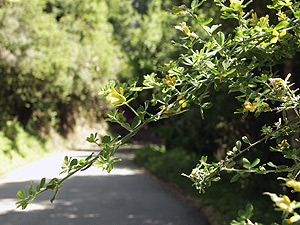In Lomond Terrace
There's been talk about putting together a group of resident volunteers to address the broom situation. If you are interested of have ideas about this, contact Michael Saunders.
What good is it?
Not much... but If you take Scotch broom flowers and soak them in water overnight, the flowers would lose all their color and the water becomes a yellow dye.
What should you do to control this noxious weed?
Dig it up, including the crown;
Cut it back to the ground each year before it sets seed;
Some people use a weed wrench
Round Up
Spanish Broom is Toxic!
Alkaloids ( Mainly cytisine and sparteine together with genistein and isosparteine); glycosides ( scoparin ); Acids (linoleic, oleic, caprylic, palmitic) tannins, oxalates...etc. Cytisine becomes hallucinogen and stimulant of the respiratory track. It is highly toxic, resulting lethal in a superior dose of 5 mg. Active parts: The whole plant (cytisine, sparteine), but specially the flowers and seeds. The flowers are very rich in scoparin and genistein is mainly found in young shoots.
Source here
Do you have a story?
Are you aware of some history or do you have photos you would like to share that pertain to our neightborhood?
Contact Me
and we can put something together for this website. I can easily scan photos and have them back to you in a couple of hours.
|
Facts About Broom
 |
| Pretty much French Broom is a part of all of our yards. Click for larger photo. [ Photo by Luckow ] |
Who Cares about Broom?
Invasive non-native plants can cause enormous changes in ecosystems by out-competing native plants, polluting the gene pool of native plants through hybridization, and dramatically altering fire, water, and nutrient cycles. Additionally, non-native plants are known to transmit non-native diseases to native plants; non-native diseases can be much more devastating than native diseases because native resistance to these diseases is often very low.Recent estimates indicate that non-native plants are infesting 4,600 new acres of federal land each day.
What Kind is Growing in Lomond Terrace?
Probably mostly French broom and some Scotch. French broom is a leafy shrub with 3-foliate leaves. It is native to the Mediterranean and the Azores. French broom is a perennial alternate-leaved shrub growing to 10' tall with villous branchlets and trifoliate, oblanceolate to obovate leaves. French broom blooms from March to May, and may be found along roadsides and in other disturbed areas, but also naturalized in some places in the w. Transverse Range and Peninsular Range not far from the coast. French broom is often confused with Scotch broom and Spanish broom.
Spanish broom is a mostly leafless shrub but when it does have leaves, they are simple. This is what most people see in southern California. Scotch broom is also mostly leafless, but it may have single leaves on the younger stems and 3 leaflets on the older. Scotch broom is generally restricted to more northerly locations but may occasionally be seen in southern California.
Identification
French broom can grow up to 3 meters (10 feet) tall. It has 3 small leaflets per leaf. The flowers are bright yellow and born in clusters. Each cluster has between 4 and 10 flowers and have a silky-hairy, three-pointed calyx and bright yellow petals with a glabrous, ovate banner to 1/2" long. The bean-like pods are hairy and are generally between 15 and 25 millimeters (0.6-1 inches) long. The ten stamens are fused into a tube about halfway along their length. The fruit is a densely villous seedpod about 1" long.
Native Look-Alikes
The only native species that may be confused with French broom is California broom (Lotus scoparius). California broom tends to have smaller leaves (6-15 millimeters or 0.2-0.6 inches long). The flowers of California broom are also smaller than the flowers of French broom.
French broom reproduces entirely by seed. Each mature plant can produce hundreds of viable seeds each year. The seeds can remain viable in the soil for up to five years. Like many of the other non-native brooms in California, French broom has the ability to thrive in both disturbed and undisturbed areas at low elevations. Once established, these plants tend to exclude all others, and their seed banks can be extremely difficult to destroy.
What should you do to control this noxious weed?
If you find it on your property:
- Dig it up, including the crown;
- Cut it back to the ground each year before it sets seed;
- Keep an eye out for seedlings each spring and get rid of them, roots and all while they are small. Since Scotch broom seed lasts for years in the soil, vigilance is necessary to prevent reinvasion by new seedlings.
Fall applications of herbicides can be effective, either by spraying the foliage or by spraying just the base of the trunk with a stronger concentration. Another alternative is to cut the plant, then treat each freshly cut stump with herbicide. Herbicide registrations may change, therefore consult your local county office.
Scientists continue to investigate biological control possibilities for Scotch broom and other noxious weeds. The Oregon Department of Agriculture has released a species of seed weevil whose larvae feed on the developing Scotch broom seedpods. They can destroy up to about 80 percent of the broom seed inside the pods.
To check to see if these seed weevils are working on your Scotch broom, pop open a mature, brown Scotch broom seedpod. Look for tiny white larvae. Do not spray plants with seed weevils.
Effective Scotch broom control - with or without herbicides - requires follow-up. The area must be retreated if seedlings sprout. Planting something else, such as grass, in the cleared area can provide competition and keep the Scotch broom from re-invading.
Other Useful Resources
|








